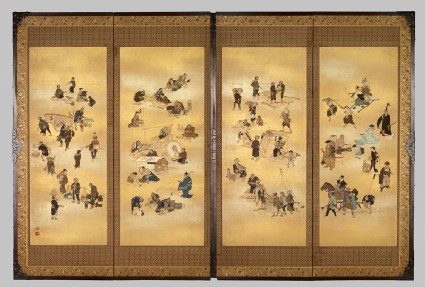Browse: 2185 objects
- Reference URL
Actions
Screen depicting the four classes of Edo Japan
-
Description
This screen, with its skilful technique, imaginative subject, and high-quality frame and mounts, may have been produced for one of the great international exhibitions that were such a feature of the late nineteenth century. The date 1893 found on a paper at the waist of a figure in the left-hand screen (the figure pulling a handcart) suggests that this may have been the World’s Columbian Exposition, held in Chicago that year. (Exhibition number 45)
-
Details
- Associated place
-
Asia › Japan › Honshū › Kyōto prefecture › Kyoto (possible place of creation)North America › north America › United States of America (World’s Columbian Exposition) (probable original location)
- Date
-
c. 1893
Meiji Period (1868 - 1912)
- Artist/maker
-
Seppō (active late 1890s) (embroiderer)possibly Tanaka Rishichi (1847 - 1902)
- Material and technique
- obverse: silk, mounted on paper, padded, and decorated with dyed and painted silk appliqué (oshi-e) and probably cotton; hard-wood frame covered in transparent lacquer; shakudō mounts reverse: ink and colour on silk
- Dimensions
-
open 182.4 x 276 x 3.2 cm max. (height x width x depth)
closed 182.4 x 69.1 x 12.8 cm (height x width x depth)
each panel 136.1 x 53.5 cm (height x width)
- Material index
-
organic › animal › animal product › silk,processed material › metal › alloy › copper alloy › shakudō
- Technique index
-
dyed,
- Object type index
- No. of items
- 1
- Credit line
- Purchased with the assistance of the Story Fund, 1995.
- Accession no.
- EA1995.87
-
Further reading
Impey, Oliver, The Art of the Japanese Folding Screen: The Collections of the Victoria and Albert Museum and the Ashmolean Museum (Oxford: Ashmolean Museum, 1997), no. 21 on p.103, illus. pp. 104-105
Impey, Oliver, and Joyce Seaman, Japanese Decorative Arts of the Meiji Period 1868-1912, Ashmolean Handbooks (Oxford: Ashmolean Museum, 2005), no. 1 on pp. 10-11, illus. pp. 10-11
Oxford: Ashmolean Museum, 9 November 2012-27 January 2013, Threads of Silk and Gold: Ornamental Textiles from Meiji Japan, Clare Pollard, ed. (Oxford: Ashmolean Museum, 2012), no. 180 p. 180, pp. 6, 31 & 32, illus. pp. 53 & 180-185
Glossary (3)
lacquer, oshi-e, shakudō
-
lacquer
Chinese and Japanese lacquer is made from the sap of the lacquer tree, which is indigenous to Eastern China. It is applied to wood as a varnish or for decorative effect. In India and the Middle East, lacquer is made from the deposit of the lac insect.
-
oshi-e
Padded figures made of silk and other fabrics, mounted onto a panel or screen. This technique dates back to the 16th century.
-
shakudō
alloy of copper and gold, patinated to a dark blue-black colour
Past Exhibition
see (1)-

Threads of Silk and Gold: Ornamental Textiles from Meiji Japan
(from 9th Nov 2012 until 27th Jan 2013)
Location
-
- currently in research collection
Objects are sometimes moved to a different location. Our object location data is usually updated on a monthly basis. Contact the Jameel Study Centre if you are planning to visit the museum to see a particular object on display, or would like to arrange an appointment to see an object in our reserve collections.
Publications online
-

Japanese Decorative Arts of the Meiji Period
A four-fold screen, each panel applied in relief with silk figures depicting the Four Classes of Edo Japan. The reverse with a painting on silk of crows. Signed with two seals; illegible and ? Setsugan, and bearing the date 1st month 1893.
The technique of oshi-e is one padded silk relief; silk wadding is covered with dyed and painted silk, adhering to the background paper. The fineness of detail is remarkable, and this screen would have been an extremely expensive item, particularly as the hard-wooded veneered frame is mounted in elaborate and very heavy soft-metal mounts, probably supplied by a former sword-fittings maker. The very heaviness of the screen as it precludes the possibility of its sale to a Japanese buyer unless he lived in a European-style house. Its sheer quality suggests that it was made for one of the major International Expositions at the end of the nineteenth century; indeed the date 1893 found on a paper at the waist of a figure in the second uppermost register of the left-hand screen (the figure pulling a handcart) suggests that this would have been the World’s Columbian Exposition in Chicago of that year. Our inability to read the uppermost seal, and our doubtful reading of the lower seal (? Setsugan) makes it impossible (so far) to find any record of the screen in that exhibition.
The subject-matter is the somewhat outdated one of the Four Classes of Edo period Japan; these had, of course, been abolished at the beginning of the Meiji period in 1868. Nevertheless, they are here represented one for each panel. Screens read from right to left, so the right hand panel represents the samurai and the warrior class. The second fold represents the farmer, here entirely occupied in the production of rice. The third fold depicts the craftsmen; hat-makers, wood-turners, a woman fan-maker, a basket-maker, a woman braid-maker, a sculptor, weavers, an embroiderer, an umbrella-maker and a potter, sword-smiths, a carpenter and bronze-casters. The left-hand panel represents the merchant class, the lowest class in society.
© 2013 University of Oxford - Ashmolean Museum





